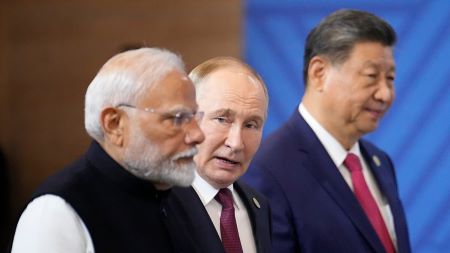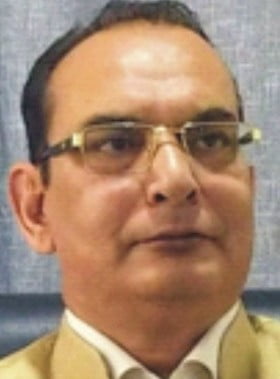The BRICS nations concluded their annual summit in the Russian city of Kazan, resolving to deepen economic ties. Plans to enhance financial cooperation and develop alternatives to Western-dominated payment systems were also discussed, with an aim to offer African nations a larger role in the evolving global order.
IN THE LAST two decades, the BRICS group has become a major political force, driven by a desire to create a counterweight to Western influence in global institutions. Its expansion in 2023 has increased its influence: with the addition of Iran, Saudi Arabia, and the United Arab Emirates (UAE), the alliance—originally comprising Brazil, Russia, India, China, and South Africa—has grown into a larger entity.
At the BRICS closing session in Kazan, Russian President Vladimir Putin noted that all countries joining the bloc “share similar aspirations, values, and a vision of a new democratic global order.”
 The three-day summit, which ended last Thursday, also provided a platform for member countries to discuss plans for strengthening financial cooperation and exploring alternatives to Western-dominated payment systems. However, the summit also exposed new disagreements on issues like Russia’s invasion of Ukraine. Russia’s 2024 leadership could heighten the bloc’s anti-Western stance, including attempts to reduce reliance on the US dollar—though experts suggest this may prove challenging.
The three-day summit, which ended last Thursday, also provided a platform for member countries to discuss plans for strengthening financial cooperation and exploring alternatives to Western-dominated payment systems. However, the summit also exposed new disagreements on issues like Russia’s invasion of Ukraine. Russia’s 2024 leadership could heighten the bloc’s anti-Western stance, including attempts to reduce reliance on the US dollar—though experts suggest this may prove challenging.
While some believe the bloc could undermine the Western-led international order, sceptics argue that its ambitions to create a shared currency and build viable alternatives to existing institutions face significant obstacles.
BRICS is not a formal organization but a loose coalition of non-Western economies aiming to counter the dominance of Western perspectives in major multilateral bodies like the World Bank, the Group of Seven (G7), and the UN Security Council.
The group’s 2024 expansion carries geopolitical implications. With its increased economic and demographic weight, the ten BRICS countries now comprise over a quarter of the global economy and nearly half of the world’s population. This expansion positions BRICS to influence issues ranging from conflicts in the Gaza Strip and Ukraine, the global economic system, competition between China and the West, and clean energy transitions.
BRICS’ thematic priorities include:
Advocating for greater representation in global organizations – The group aims to reform existing institutions and form negotiating blocs within them.
Coordinating balanced economic policies – The 2008 global recession deeply impacted BRICS economies, prompting the group to emphasize economic coordination on issues such as tariff policy, critical resource export restrictions, and investment.
Developing a new global payment system – To reduce dependence on the US dollar, BRICS leaders have long advocated for de-dollarization, favouring increased trade in local currencies or a potential shared BRICS currency.
Creating an alternative finance system – The New Development Bank (NDB) and Contingent Reserve Arrangement (CRA) are intended to mirror the World Bank and International Monetary Fund (IMF), fostering South-South cooperation and decreasing reliance on traditional funding sources.
 The BRICS countries aim to reduce the US dollar’s dominance in international trade, primarily by increasing the use of their own currencies, particularly China’s Renminbi. There is also momentum to establish a BRICS-wide currency or other monetary proposals, such as a cryptocurrency or a currency basket.
The BRICS countries aim to reduce the US dollar’s dominance in international trade, primarily by increasing the use of their own currencies, particularly China’s Renminbi. There is also momentum to establish a BRICS-wide currency or other monetary proposals, such as a cryptocurrency or a currency basket.
Meanwhile, Western nations have largely downplayed BRICS’ growth. U.S. National Security Advisor Jake Sullivan stated that Washington does not view BRICS as a geopolitical rival, and Treasury Secretary Janet Yellen has dismissed efforts to move away from the dollar. Similarly, German Foreign Minister Annalena Baerbock has downplayed the strengthening ties among BRICS members.
However, some European policymakers warn of an increasing anti-Western sentiment, viewing the expansion as a response to the West’s inadequate support for low-income countries. They argue that Western countries must initiate meaningful financial reforms.
While this year’s Summit Declaration may offer limited substance, numerous bilateral meetings on the sidelines reveal more about BRICS’ direction. Notably, Indian Prime Minister Narendra Modi and Chinese President Xi Jinping held their first face-to-face discussion in five years.

Modi Putin And Xi
This marks a shift from recent months when tensions between New Delhi and Beijing ran high, leading Modi to cancel his participation in the Shanghai Cooperation Organisation summit in Astana, Kazakhstan. Now, with an agreement over their longstanding border dispute, China and India—the two most populous and economically powerful BRICS members—have an opportunity to rebuild relations.
Warming relations between China and India could drive BRICS forward in its ambitious goals to envision and implement a new global order. This could shift BRICS leadership from China and Russia to China and India, potentially moving its agenda from an anti-Western to a non-Western focus.
The summit also provided Putin with a platform to promote his vision of BRICS as a counterpoint to the US-led West, a view likely shared among countries in the Global East—Russia, China, and Iran, as well as non-BRICS states like North Korea, Cuba, and Venezuela. However, members in the Global South, particularly India and Brazil, are unlikely to fully endorse this stance. They seek to maximize BRICS benefits while maintaining close ties with the West.
India stands as a key BRICS player in balancing East and West interests. Yet the group’s complex expansion drive reflects an internal struggle over its future direction. This tension provides the West with an opportunity to play a more constructive role in reshaping the global order.
Also Read: Book Revives Controversy Over Trump’s Secret Contacts With Putin
While the Global East may seem beyond reconciliation, there remains a significant opportunity to re-engage with the Global South, led by India. ![]()
Also Read: Human Dimension and Greed Angle of the ME Conflict
Disclaimer : PunjabTodayNews.com and other platforms of the Punjab Today group strive to include views and opinions from across the entire spectrum, but by no means do we agree with everything we publish. Our efforts and editorial choices consistently underscore our authors’ right to the freedom of speech. However, it should be clear to all readers that individual authors are responsible for the information, ideas or opinions in their articles, and very often, these do not reflect the views of PunjabTodayNews.com or other platforms of the group. Punjab Today does not assume any responsibility or liability for the views of authors whose work appears here.
Punjab Today believes in serious, engaging, narrative journalism at a time when mainstream media houses seem to have given up on long-form writing and news television has blurred or altogether erased the lines between news and slapstick entertainment. We at Punjab Today believe that readers such as yourself appreciate cerebral journalism, and would like you to hold us against the best international industry standards. Brickbats are welcome even more than bouquets, though an occasional pat on the back is always encouraging. Good journalism can be a lifeline in these uncertain times worldwide. You can support us in myriad ways. To begin with, by spreading word about us and forwarding this reportage. Stay engaged.
— Team PT

